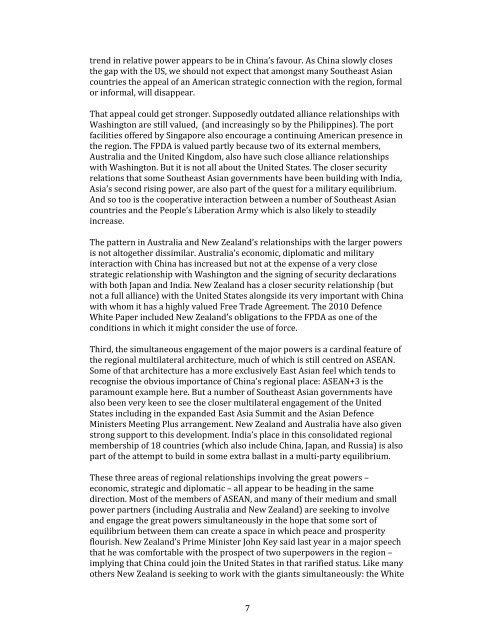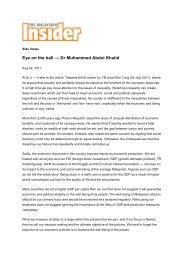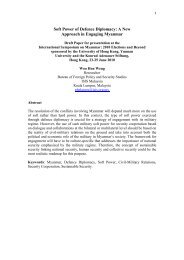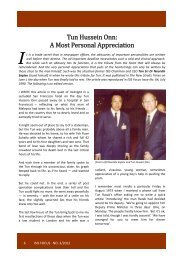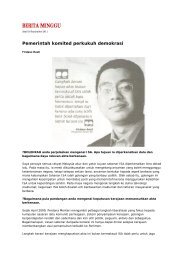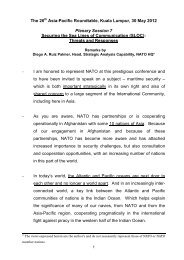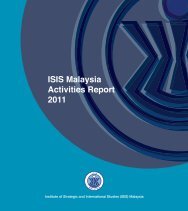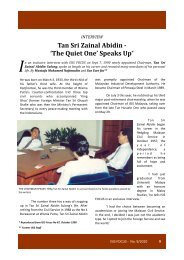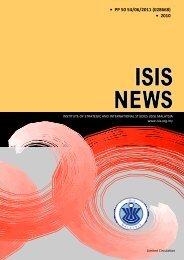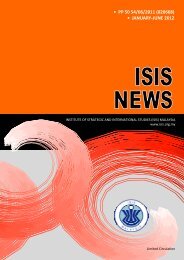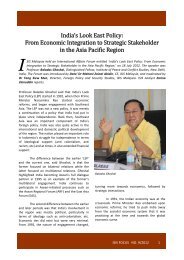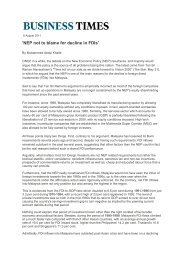ZOPFAN - ISIS Malaysia
ZOPFAN - ISIS Malaysia
ZOPFAN - ISIS Malaysia
Create successful ePaper yourself
Turn your PDF publications into a flip-book with our unique Google optimized e-Paper software.
trend in relative power appears to be in China’s favour. As China slowly closes<br />
the gap with the US, we should not expect that amongst many Southeast Asian<br />
countries the appeal of an American strategic connection with the region, formal<br />
or informal, will disappear.<br />
That appeal could get stronger. Supposedly outdated alliance relationships with<br />
Washington are still valued, (and increasingly so by the Philippines). The port<br />
facilities offered by Singapore also encourage a continuing American presence in<br />
the region. The FPDA is valued partly because two of its external members,<br />
Australia and the United Kingdom, also have such close alliance relationships<br />
with Washington. But it is not all about the United States. The closer security<br />
relations that some Southeast Asian governments have been building with India,<br />
Asia’s second rising power, are also part of the quest for a military equilibrium.<br />
And so too is the cooperative interaction between a number of Southeast Asian<br />
countries and the People’s Liberation Army which is also likely to steadily<br />
increase.<br />
The pattern in Australia and New Zealand’s relationships with the larger powers<br />
is not altogether dissimilar. Australia’s economic, diplomatic and military<br />
interaction with China has increased but not at the expense of a very close<br />
strategic relationship with Washington and the signing of security declarations<br />
with both Japan and India. New Zealand has a closer security relationship (but<br />
not a full alliance) with the United States alongside its very important with China<br />
with whom it has a highly valued Free Trade Agreement. The 2010 Defence<br />
White Paper included New Zealand’s obligations to the FPDA as one of the<br />
conditions in which it might consider the use of force.<br />
Third, the simultaneous engagement of the major powers is a cardinal feature of<br />
the regional multilateral architecture, much of which is still centred on ASEAN.<br />
Some of that architecture has a more exclusively East Asian feel which tends to<br />
recognise the obvious importance of China’s regional place: ASEAN+3 is the<br />
paramount example here. But a number of Southeast Asian governments have<br />
also been very keen to see the closer multilateral engagement of the United<br />
States including in the expanded East Asia Summit and the Asian Defence<br />
Ministers Meeting Plus arrangement. New Zealand and Australia have also given<br />
strong support to this development. India’s place in this consolidated regional<br />
membership of 18 countries (which also include China, Japan, and Russia) is also<br />
part of the attempt to build in some extra ballast in a multi‐party equilibrium.<br />
These three areas of regional relationships involving the great powers –<br />
economic, strategic and diplomatic – all appear to be heading in the same<br />
direction. Most of the members of ASEAN, and many of their medium and small<br />
power partners (including Australia and New Zealand) are seeking to involve<br />
and engage the great powers simultaneously in the hope that some sort of<br />
equilibrium between them can create a space in which peace and prosperity<br />
flourish. New Zealand’s Prime Minister John Key said last year in a major speech<br />
that he was comfortable with the prospect of two superpowers in the region –<br />
implying that China could join the United States in that rarified status. Like many<br />
others New Zealand is seeking to work with the giants simultaneously: the White<br />
7


